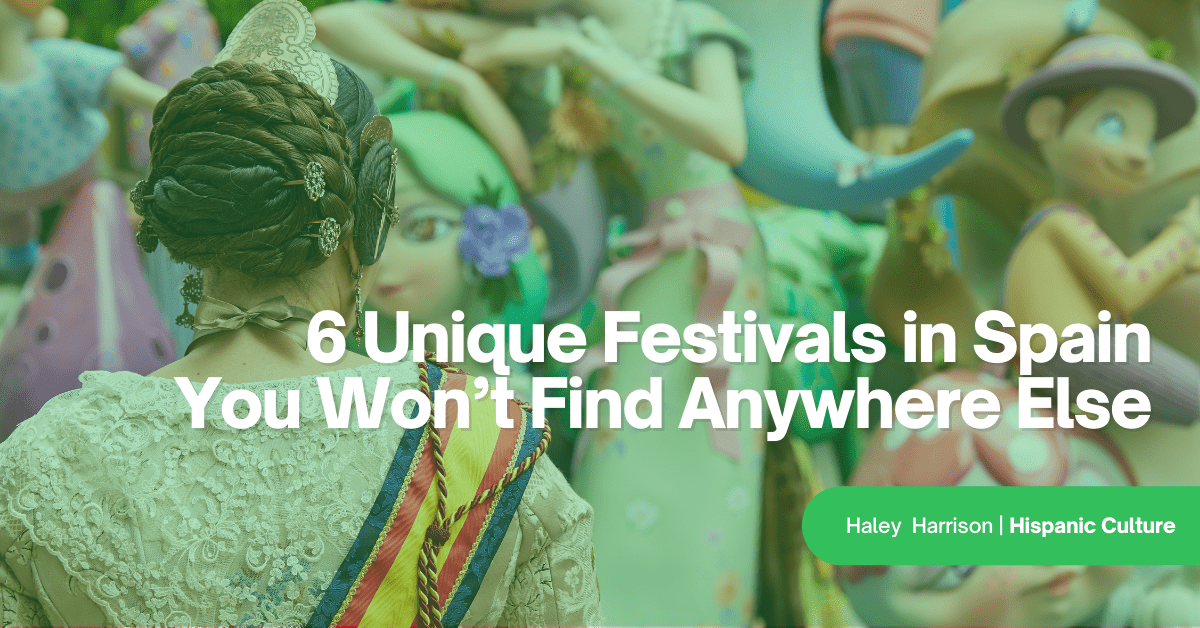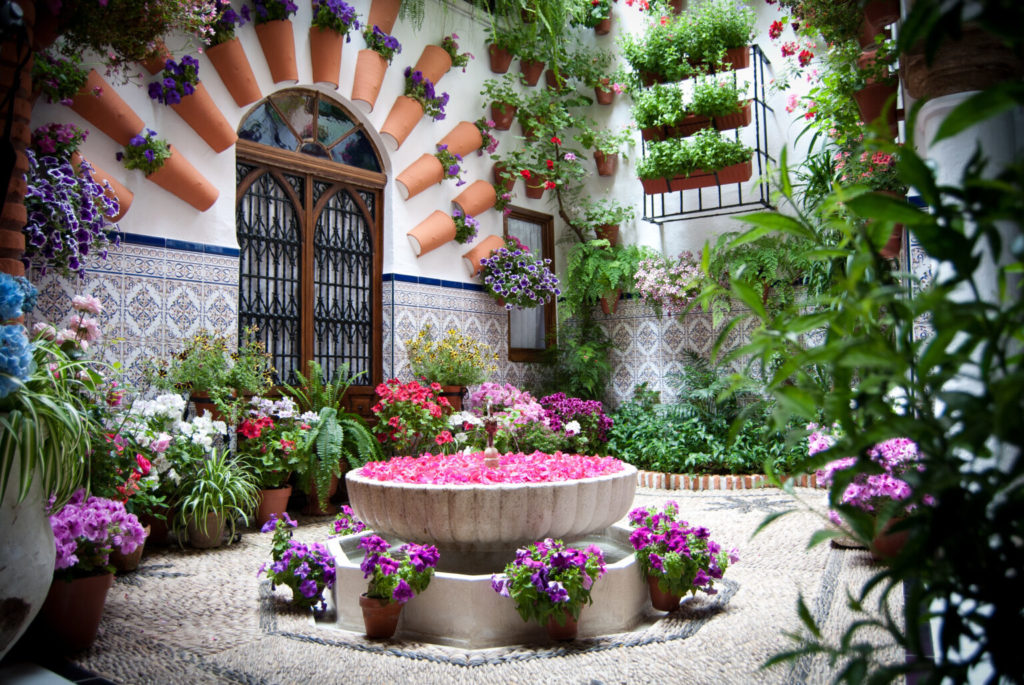
6 Unique Festivals in Spain You Won’t Find Anywhere Else
Spain wouldn’t be the culturally rich country we know today without its many festivals.
Across the country, Spaniards and curious visitors join in some of the most extraordinary celebrations that captivate even the most veteran traveler.
Let’s dive into some of the most unique festivals in Spain, which are only available there.
Gain confidence in your language skills with our friendly, certified teachers.
Sign up for your no-risk, free-trial Spanish class today. ➡️

1. La Feria de Abril – Seville
What began as a modest cattle fair in 1847 has transformed into Seville’s most revered celebration: La Feria de Abril, which translates into “April’s Fair.”
This fair occurs a few weeks after Semana Santa in the Spring.
Locals celebrate by dancing Flamenco, eating tapas, drinking wine, and partying late into the night with friends and family.
Every year, feria-goers vie for a spot in a caseta, a private tent owned by a local family. These tents line the entire length of the fairgrounds and are the center of the celebration.
It’s like you’re in a different era!
In the streets and the fairgrounds, you will see women wearing traditional Flamenco dresses and dancing to soulful Spanish guitar tunes. They often travel around the Feria in one of the city’s many horse-drawn carriages and are a cornerstone representation of the Feria de Abril.
2. Els Enfarinats – Ibi, Alicante
In Spain, December 28th is known as the Day of the Innocents, which recognizes the New Testament story of King Herod’s massacre of infant boys in an attempt to kill Jesus.
Despite its dark past, people now commemorate December 28th with light-hearted jokes and pranks. It’s their version of our April Fool’s Day.
Nowhere is the day more uniquely-celebrated than in Ibi, in the province of Alicante, Spain. In Ibi, residents have gathered for over 200 years to throw eggs and flour at each other during Els Enfarinats, which means “The Floured Ones” in Valencian.
“The Floured Ones” festival may be a mess, but it is full of joy and laughter.
At 8 am, townspeople are already lining the streets waiting for men in military uniforms to arrive with their faces painted in bright colors. They stage a coup d’état, declare a mayor, and begin enforcing bizarre laws.
When residents have had enough, La Oposicio (The Opposition) fights back by throwing eggs and flour at their new pretend leadership.
Firecrackers go off, creating colorful clouds of smoke, and by the end of the day, the fake mayor has stepped down, and participants are well-battered and ready for a shower.
If you find yourself in Alicante on December 28th, be careful, or you might get egged!
3. Batalla de Vino – Haro, La Rioja
This holiday, which translates to “The Battle of Wine,” takes place in the heart of the Spanish wine country of La Rioja, and it’s exactly what its name implies.
Are there any wine aficionados out here? This is your place to be! Or not!
On the morning of June 29, townspeople gather outside near Riscos de Bilibio to commence the La Batalla de Vino and douse themselves and their friends in bright red wine.
By the afternoon, everyone’s white clothes have turned purple, and participants are ready to recover their energy eating snails, lamp chops, and other delicious delicacies.
The party doesn’t stop there, however.
Once the feast has concluded, everyone makes their way back to the town of Haro to continue the festivities with music, and people dance in the streets like there’s no tomorrow.
The celebration goes back to the 6th century when people made pilgrimages to San Felices de Bilibio’s burial site. By the 20th century, those pilgrimages turned into baptism celebrations, which gave life to the wine battle we know today.
4. La Fiesta de los Patios – Córdoba
Known for its famous Mezquita, the Roman bridge, and the Calahorra tower, the Andalusian city of Córdoba is also home to an important UNESCO Heritage Site: La fiesta de los patios.
Every spring, proud residents adorn the patio courtyards of their homes with colorful flowers, stone mosaics, and ceramic decorations to celebrate the Córdoba Patio Festival.
These old-style homes are open to the public typically during May and sometimes host small artisanal markets to draw in more visitors.
Patio courtyards are a symbol of Andalusian architecture, which dates back to the days of the Romans and incorporates elements of Nothern African and Spanish styles.
These central patios are a way to keep cool during the region’s hot summer months, and today, they serve both practical and cultural purposes.
The Cordoba City Hall began this tradition in 1918, which continues to be one of the city’s most charming attractions.

5. El Colacho – Castrillo de Murcia, Burgos
On the first Sunday after Corpus Christi, residents in Castrillo de Murcia celebrate the triumph of good over evil in a rather unusual way.
El Colacho, a pestering character who represents the devil, has one goal: to spoil the town’s joyful celebration.
As he marches through the street in his bright yellow and red costume, children and parade-goers insult him until he ultimately fails in his mission.
By the day’s end, good has officially defeated evil.
Everyone in the town has a role to play during the day of El Colacho, even the children. During the most noteworthy part of the parade, El Colacho races through the streets and jumps over mattresses holding several babies. As soon as he leaps, the town priest blesses the infants.
The odd tradition dates back to the Middle Ages and continues to grow in popularity.
Here’s a nice peak of that iconic leap we mentioned earlier!
6. Las Fallas – Valencia
In March, residents gather in Valencia to celebrate the region’s most significant holiday: Las Fallas.
For three weeks, the city celebrates with parades, musical performances, fireworks, religious offerings, and partying.
The main spectacle are the ninots: giant papier-mache floats that stand over 20 feet tall and depict celebrities, politicians, fictional characters, and other pop culture figures.
It’s quite common to see Spiderman next to Putin and Donald Trump during Las Fallas.
One of the important days is dedicated to the city’s patron Virgin: “Our Lady of the Forsaken.”
Attendees, known as falleros, dress in traditional Valencian clothing and dance at the Plaza de la Virgen, where they present her with flowers.
On other days, the townspeople come to watch the mascletas, which are concerts of fireworks and gunpowder explosions.
At the end of the Fallas celebrations, people gather to participate in the Nit del Foc (The Night of Fire), in which they set the ninots on fire on a giant bonfire.
Learn Spanish Culture with Spanish Language Classes
Did these celebrations spark any wanderlust? Did you learn anything new?
If you’re interested in learning more about Spanish customs and traditions, head to our blog for more educational resources.
If you’re considering learning Spanish, consider signing up for a free trial class.
Our native-speaking teachers specialize in providing student-tailored Spanish programs and flexible scheduling to make it easy and convenient. So whether you’re a beginner adult or interested in having your child learn Spanish, there is a teacher for you.
We can’t wait to help you learn more about the Spanish language and culture. We’ll be waiting!

Join one of the 40,000 classes that we teach each month and you can experience results like these…

“This is the best way for your kid to learn Spanish. It’s one-on-one, taught by native Spanish speakers, and uses a curriculum.”
– Sharon K, Parent of 3

“It’s a great way to learn Spanish, from native Spanish speakers in a 1-on-1 environment. It’s been fairly easy to schedule classes around my daughter’s other classes. The best value for us has been ordering multiple classes at a time. All the instructors have been great!”
– Cindy D, Parent of 3

“HSA offers very affordable, quality, one on one classes with a native speaker. My son has greatly benefited from taking classes. We have seen his confidence increase as well as his pronunciation improve, because he learns from a native Spanish speaker. HSA has quick, personal customer service. Our family has been very pleased with our experience so far!”
– Erica P. Parent of 1
Do you love Hispanic culture? Check out our latest posts!
- Celebrating Culture and Joy: The Magic of Carnival in Spanish-Speaking Countries
- 15 Mouth-Watering National Dishes of Latin America
- Discovering The Mayan Languages
- The 10 Most Common Spanish Surnames in The U.S
- Everything About Mexican Christmas Traditions
- What Is the Hispanic Scholarship Fund? Is It Legit?
- A Spanish Guide to Thanksgiving Food Vocabulary
- How Did All Saints Day Celebrations Started?
- Languages in Spain: How Many Languages Are Spoken in Spain? - March 17, 2023
- 6 Unique Festivals in Spain You Won’t Find Anywhere Else - March 5, 2023
- Which Family Language Strategy Works for You? - March 2, 2023





